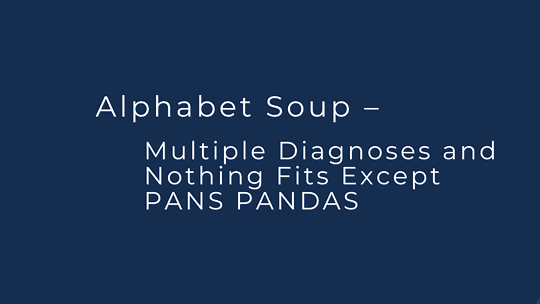Monthly Archives:
October 2020

A Long Slow Road to PANS PANDAS Recovery
Around 4th grade, Sylvie was at a friend's house, and I received a call that she wanted to come home. She was scared as she had seen something upsetting on TV; turns out it was a cat that had fallen...

Alphabet Soup – Multiple Diagnoses and Nothing Fits Except PANS PANDAS
I was so relieved to have a diagnosis that made sense finally, which gave us the hope of treating and recovering our...
Borrelia miyamotoi Serology in a Clinical Population With Persistent Symptoms and Suspected Tick-Borne Illness
Borrelia miyamotoi Serology in a Clinical Population With Persistent Symptoms and Suspected Tick-Borne Illness
Delaney Shannon L., Murray Lilly A., Aasen Claire E., Bennett Clair E., Brown Ellen, Fallon Brian A. Borrelia miyamotoi Serology in a Clinical Population With Persistent Symptoms and Suspected Tick-Borne Illness. Front. Med., 27 October 2020 . DOI=10.3389/fmed.2020.567350
ABSTRACT=Eighty-two patients seeking consultation for long-term sequalae after suspected tick-borne illness were consecutively tested for Borrelia miyamotoi antibodies using a recombinant glycerophosphodiester phosphodiesterase (GlpQ) enzyme immunoassay. Twenty-one of the 82 patients (26%) tested positive on the GlpQ IgG ELISA. Nearly all of the patients (98%) had no prior B. miyamotoi testing, indicating that clinicians rarely test for this emerging tick-borne pathogen. Compared to patients who solely tested positive for Lyme disease antibodies, patients with B. miyamotoi antibodies presented with significantly more sleepiness and pain. A prospective study is needed to ascertain the relationship between the presence of B. miyamotoi antibodies and persistent symptoms.

Standing Up to OCD Workbook For Kids: 40 Activities to Help Children Stop Unwanted Thoughts, Control Compulsive Behaviors, and Overcome Anxiety
Standing Up to OCD Workbook For Kids: 40 Activities to Help Children Stop Unwanted Thoughts, Control Compulsive Behaviors, and Overcome Anxiety by Tyson Reuter PhD Show your worries who’s...

PANS Patient Story – When an Eating Disorder is Due to PANS PANDAS
Note from ASPIRE: This is a must-read PANS PANDAS Patient Story. A typical happy young girl develops a severe eating disorder and other PANS PANDAS symptoms; then, she suffers through...

The Wall Was Hard to See
This story exemplifies how it is sometimes hard to see the sudden onset or sudden worsening of PANS PANDAS symptoms as you are living (struggling) through it. Remember, someone with PANS PANDAS does...
The Jarisch-Herxheimer reaction associated with doxycycline in a patient with Lyme arthritis
- A 13-year-old boy developed Lyme arthritis and experienced a severe Jarisch-Herxheimer reaction on day 7 of doxycycline treatment.
- Symptoms included low-grade fever, severe joint and muscle pain, and increased inflammatory markers.
- Unlike the typical mild, short-lived reaction seen in adults, this case was prolonged and intense.
- Raising awareness among healthcare professionals can help differentiate this reaction from allergies or other conditions, improving patient care.
Psychosocial Interventions and Immune System Function – A Systematic Review and Meta-analysis of Randomized Clinical Trials
- Inflammation-linked diseases cause over 50% of global deaths. Psychosocial interventions may help, but it’s unclear which work best and for whom.
- Study: Systematic review and meta-analysis of 56 RCTs (4,060 participants) across 8 psychosocial interventions and 7 immune markers.
- Findings: Interventions led to a 14.7% improvement in beneficial immune function and 18% reduction in harmful immune activity.
- Most effective: CBT and combined/multiple interventions, especially those targeting proinflammatory markers.
- Lasting effects: Benefits persisted at least 6 months post-treatment and held across age, sex, and treatment duration.
- Conclusion: Psychosocial interventions reliably improve immune function and may be a useful public health strategy.